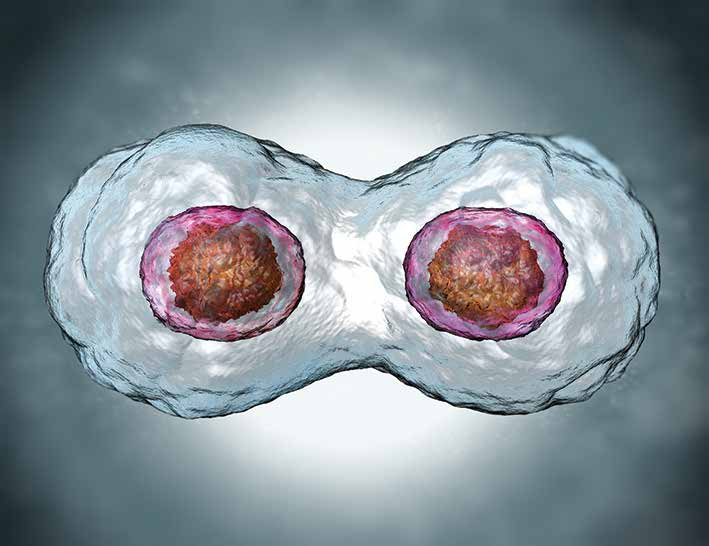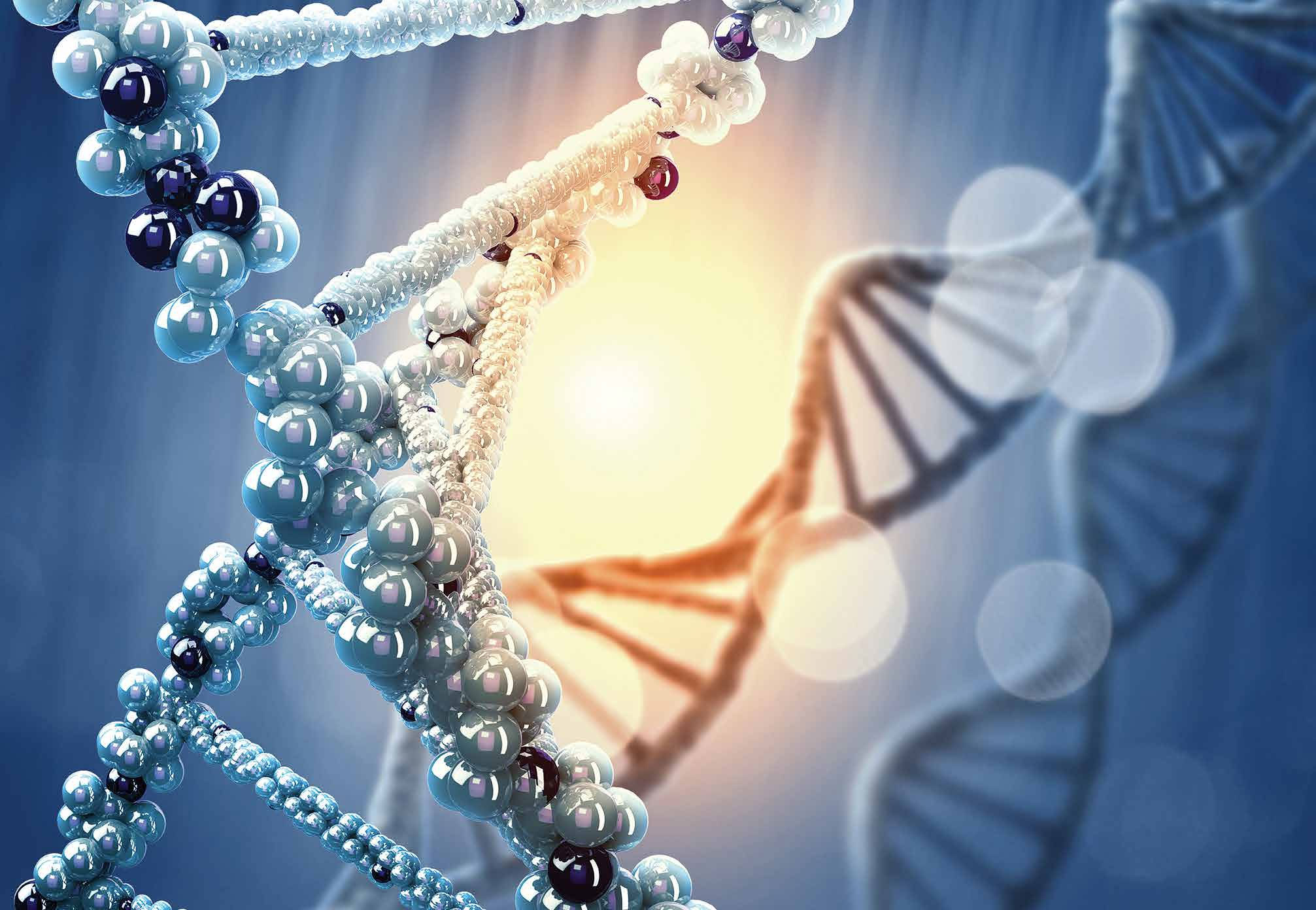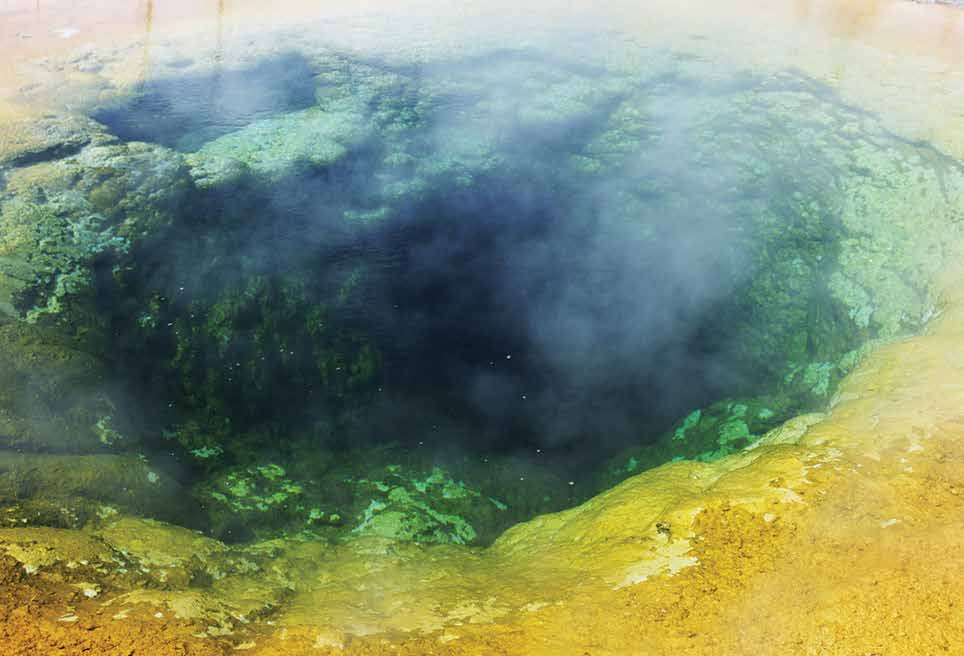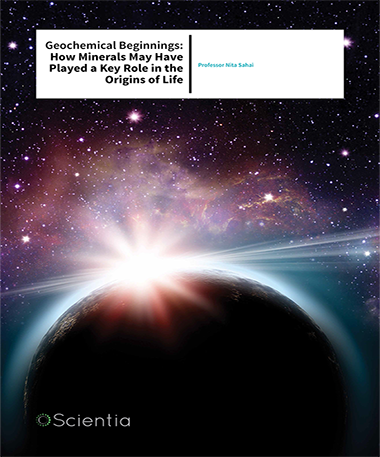Professor Nita Sahai – Geochemical Beginnings: How Minerals May Have Played A Key Role In The Origins Of Life
Professor Nita Sahai, of the University of Akron, studies the geochemistry underlying protocell formation and evolution, with a view to understanding the origins of life. This fascinating research is applicable to understanding both how life started on our own planet, and how it may arise on others.

Life on our planet is colourful, varied, pervasive and tenacious. Evolution has furnished the Earth with a vast array of species, for whom survival, competition and reproduction are innate instincts. These properties of life, can, under optimal conditions, drive self-replication and ever increasing biodiversity, in perpetuity. Life on Earth is programmed to survive and thrive. From microbes to mammals, from deep sea trenches to volcanic vents and frozen ice caps, life in all its forms has adapted to the myriad habitats our blue sphere has to offer, elegantly, doggedly, successfully. But where did it all begin?
The origins of life on Earth remain a fundamental and profound mystery. As a species, our consciousness and selfawareness dictate that we are inherently curious about our own origins and those of the other species that share our planet. Such thinking forms the basis of much of our art, philosophy, religion and science.
 Scientists have determined that life on Earth likely arose between 3.8 and 4.2 billion years ago. These first unicellular organisms evolved to become more complex, eventually forming the multitude of species that inhabit almost every conceivable habitat on the planet. Professor Sahai spoke with Scientia about her motivations for scientific investigation into our origins: ‘To me, the scientific approach is the most robust and intellectually satisfying to answering the questions about the origins of life. Finding the answers to these tremendously difficult questions, more than any other I can think of, requires the integration of knowledge from a wide array of fields such as Geochemistry, Earth History, Biochemistry, Organic Chemistry, Meteoritics, Planetary Science, Exo-solar Planets, and Astronomy.’
Scientists have determined that life on Earth likely arose between 3.8 and 4.2 billion years ago. These first unicellular organisms evolved to become more complex, eventually forming the multitude of species that inhabit almost every conceivable habitat on the planet. Professor Sahai spoke with Scientia about her motivations for scientific investigation into our origins: ‘To me, the scientific approach is the most robust and intellectually satisfying to answering the questions about the origins of life. Finding the answers to these tremendously difficult questions, more than any other I can think of, requires the integration of knowledge from a wide array of fields such as Geochemistry, Earth History, Biochemistry, Organic Chemistry, Meteoritics, Planetary Science, Exo-solar Planets, and Astronomy.’
Put simply, scientists like Professor Sahai and her team theorise about how life could arise from non-living primitive materials, under specific conditions. In particular, it is important that these materials, both inorganic and organic, and environmental conditions be as reflective as possible of what is thought to have existed on Earth during the period that life first arose. Determining what these building blocks were, and what conditions were required to enable them to combine and interact in ways that resulted in the inception and survival of primordial life, is a fascinating and interdisciplinary branch of scientific endeavour.
‘The over-arching goal of my research program in the Origins of Life is the bottom-up assembly of a “protocell” under realistic and plausible ranges of early Earth environments’

The Protocell
So what would this early life have looked like? A protocell, which is a hypothesized primitive cell-like entity that is believed to have preceded the earliest cells, may be described as having the minimal characteristics shared by all forms of life. These characteristics include a lipid membrane, to enclose and protect all the other components. They also include a metabolic system, which constitutes energy-transfer reactions. Such reactions must be catalysed, either by enzyme-like molecules or by other chemicals. The protocell must also have included some genetic material, to permit for hereditary transfer and reproduction, which is likely to have been a much more primitive form of DNA (deoxyribonucleic acid) and is widely assumed to be RNA (ribonucleic acid). Although we can describe the protocell as ‘primitive’, in comparison with the complex life forms that currently inhabit the planet, the conditions, materials and reactions that were necessary for it to arise from non-living material likely demonstrated a complex interplay. The chemistry required to give rise to these characteristics creates what Professor Sahai refers to as a ‘chickenand- egg problem’. Before the existence of biological processes (such as the catalytic function of enzymes) what could have caused these reactions to occur? The protocell is thought to have evolved after the time that liquid water became stable on Earth, about 4.2 billion years ago. The first signs of life on Earth that have been detected in rock have been dated at approximately 3.8 billion years old. Therefore, the protocell is thought to have emerged at some point before this. Professor Sahai tells us about how the protocell concept is at the basis of her research, and is applicable to life on this planet and others: ‘The over-arching goal of my research program in the Origins of Life is the bottom-up assembly of a “protocell” under realistic and plausible ranges of early Earth environments, and to identify potential relationships between protocell stability and environmental conditions to predict the habitability of other solid worlds.’
Bottom-up Protocell Self-Assembly
One of the key components of the protocell is an enclosing membrane, which can spontaneously form from lipids into what is known as a bilayer membrane that encloses and protects the other components of the cell. These lipids will naturally form into layers and spherical vesicles under the right conditions. Professor Sahai investigates how mineral surfaces could have played either a stabilising or disrupting role in the formation of a protocell membrane from such lipid molecules, or affected the rate at which they form.
The influence of minerals on bilayer self assembly has been previously investigated by a variety of researchers from different fields. However, universal relationships between lipid assembly and mineral chemistry have not yet been established. The surface properties of minerals are numerous and characterising their interactions with lipids is a complex task. Other confounding processes include difficulties accounting for the influence of gravity on mineral particles, which can cause them to settle out in solution, thereby limiting their contact with lipids.
Professor Sahai and her team examine the influence of a wide range of synthetic inorganic solids, and natural minerals and rocks, on vesicleformation rates, thermodynamic stability, and membrane permeability. The team study the crystal structure, chemical composition, particle shape and size, surface charge and solubility of minerals, with a view to identifying what are known as structure-activity relationships (SARs) between lipid membrane formation, environmental conditions and mineral properties. This means that they employ minerals of varying structure or chemistry and/or vary the environmental conditions slightly to see what effect these changes have on membrane formation. Excitingly, if such a relationship can be comprehensively established, the team may be able to predict whether cell membranes can be stable on other solid worlds. Professor Sahai tells us about how her research is applicable to other planets and how SARs are a useful tool to parse the numerous combinations of factors that are involved in these complex dynamics. ‘In the laboratory, we can only examine a limited number of minerals, solution compositions, temperatures, etc. Contrast that to the thousands of minerals known and the wide range of geochemical solution compositions and temperatures from sub-zero in the polar regions to those found at deep-sea hydrothermal vents (at around 300ºC). It would be virtually impossible to study all of them to examine whether specific organic molecules would be stable or not in all those environments,’ she explains. ‘So, identifying SARs would be groundbreaking because they may help predict the plausible self-assembly of prebiotic organic molecules and protocell emergence on other solid worlds such as Mars, the moons of Earth, Jupiter, Saturn and exosolar planets, as their mineralogy becomes known. This is especially important for solid worlds that are too remote to send landers or rovers on to sample their surfaces or atmospheres directly.’

‘The multi- and interdisciplinary nature of this research area is exciting because, for one, I am always learning something new and am living at the edge of my own area of expertise’
Early Earth Environments – a Cocktail for Primordial Life
Determining what substances were present in the early Earth environment, and what forms and levels they were present in, is also crucial to Professor Sahai’s work. Using this information to determine what effect the environment had on protocell formation is at the crux of the work. One aspect of this is looking at available phosphate in the early Earth environment. Phosphate is a component of numerous biological building blocks, such as nucleotides and phospholipids, and it is thought that much higher levels of phosphate and magnesium were required to enable the non-enzymatic (prebiotic) formation of certain biological components, such as nucleotides, compared with biological enzymatic reactions. However, levels of available phosphate on the early Earth are believed to have been hampered by the limited solubility of a calcium phosphate mineral (hydroxyapatite), a conundrum known as the ‘phosphate problem’.
Building up a realistic picture of the conditions present in the early Earth environment is important to accurately model the interactions of molecules present in such an environment. In collaboration with Professor Martin Schoonen at Stony-Brook University, New York, the team have set out to determine if biologically-relevant levels of magnesium, calcium and phosphate can exist under plausible early Earth temperatures and atmospheric levels of carbon dioxide. The team employ geochemical modelling techniques to analyse atmosphere-water-rock interactions to answer these questions.
The Origins of Life: An Interdisciplinary Discipline
The potential to undertake collaborations, such as the one described above, and the interdisciplinary nature of this research is part of what attracted Professor Sahai to this field of research: ‘The multi- and inter-disciplinary nature of this research area is exciting because, for one, I am always learning something new and am living at the edge of my own area of expertise. What I mean is that multidisciplinary work stimulates my creativity to ask questions at the boundaries between multiple fields and my own core expertise in geochemistry,’ she explains. ‘My research and that of other scientists in the origins of life research area can be mutually informed by the knowledge and open questions in the others’ fields to create potential breakthroughs that would not otherwise be possible.’
Professor Sahai is also keen to acknowledge the contributions of the students and post-doctoral scientists in her group, and the support that her team has received for their work to date: ‘This research has been funded by two NSF grants (CAREER and a current one), NASA Astrobiology Institute and the Simons Collaboration on the Origins of Life (SCoL). The Simons Foundation Collaboration of Life (SCoL) involves about 20 Principal Investigators, and we span a wide range of expertise from Astronomy and Meteoritics to Physics, Biochemistry and Geochemistry. The grant is funded for five years at a level of more than $80 million(http://www.simonsfoundation.org/life-sciences/simonscollaboration- on-the-origins-of-life/).The SCoL is directed by Dr Jack Szostak, Nobel Laureate 2009 and Howard Hughes Medical Institute (HHMI) Investigator, and by Dr Dimitar Sasselov, who has discovered many exoplanets.
Meet the researcher

Professor Nita Sahai
Fellow of the Mineralogical Society of America Ohio Research Scholar – Biomaterials
Department of Polymer Science
Department of Geosciences
Integrated Bioscience Program
University of Akron
Akron, USA
Professor Nita Sahai holds the position of Ohio Research Scholar in Biomaterials at the Department of Polymer Science and the Department of Geosciences, University of Akron. She was awarded her PhD degree in 1997 for her work on electrolyte adsorption at the Department of Earth and Planetary Sciences in Johns Hopkins University, Baltimore. As a postdoctoral researcher, she went on to investigate strontium adsorption at oxide and silicate surfaces at Arizona State University, and studied silica and apatite biomineralisation at the Department of Chemistry and Biochemistry, University of Maryland. In 2000, Professor Sahai obtained her first professorship in the Department of Geoscience at the University of Wiscosnin–Madison, where she worked for 11 years before taking her current position at the University of Akron in 2011. Professor Sahai is a Fellow of the Mineralogical Society of America. Over the course of her varied career, she has been presented with many awards, including Distinguished Lecturer of the Mineralogical Society of America, Romnes Faculty Fellowship – University of Wisconsin–Madison and the NSF CAREER award.
CONTACT
E: sahai@uakron.edu
T: (+1) 330 9725795
W: http://biomin.uakron.edu/
KEY COLLABORATORS
Professor Martin Schoonen, Stony-Brook University, USA
Professor Qiang Cui, University of Wisconsin-Madison, USA
FUNDING
NSF Earth Sciences Geobiology and Low-Temperature Geochemistry Program
Simons Collaboration on the Origins of Life (SCoL)
NASA Astrobiology Institute
REFERENCES
N Sahai, H Kaddour, P Dalai, Z Wang, G Bass and M Gao M, Mineral surface chemistry and nanoparticle-aggregation control membrane self-assembly, Scientific Reports, 2017, accepted for publication.
N Sahai, H Kaddour and P Dalai P, The transition from geochemistry to biogeochemistry, Elements, 2016, 12, 389–394.
J Xu, N Sahai, CM Eggleston and MAA Schoonen, Reactive oxygen species at the oxide/water interface: Formation mechanisms and implications for prebiotic chemistry and the origin of life, Earth and Planetary Science Letters, 2013, 363, 156–167.
J Xu, J Campbell, N Zhang, WJ Hickey and N Sahai, Evolution of bacterial biofilms as armor against mineral toxicity, Astrobiology, 2012, 12, 785–798.
TA Oleson, N Sahai and JA Pedersen, Electrostatic effects on deposition of multiple phospholipid bilayers at oxide surfaces, Journal of Colloid and Interface Science, 2010, 352, 327–336.


